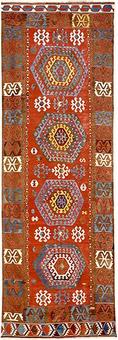Antique wide runner No. 43591 Kilim, ca. 1850 Anatolia 412 x 140 cm

Larger images (will open in new window)
Please click on the thumbnails below for a larger view
| main view |
 |
| Item Number: |
43591 |
| Name: |
Kilim, ca. 1850 |
| Country of Origin: |
Anatolia |
| Size: |
412 x 140 cm |
| Made:
|
ca. 1850 |
Foundation
(warp and weft): |
wool (this is a flatweave without pile) |
| Design: |
geometric / allover |
| Ground Color: |
rust |
| Remarks: |
This is a unique handmade / hand-knotted / traditional oriental flatweave |
 add to cart
add to cart
This is an Oriental nomadic rug. The word "nomad" comes from the Greek word "nemein". Nomads are wandering tribes, shepherds, stockbreeders, or hunters. In the minorly populated areas of Asia and North Africa they move with their herds, all their belongings and their tents to new places constantly. Many states already tried to make them settle down with various success. Mostly it is the women of the tribes which contribute to the family's income with their carpet knotting and weaving while the men breed stock or go hunting. But due to the circumstances of nomadic life the carpet production often lacks regularity and precision in form and design, which actually adds to their originality and makes them even more popular. The wool is mostly dyed with vegetable dyes.
This piece is a Kilim. What is a Kilim? "Kilim" is a generic term for all Oriental rugs which have no pile (also Palas, Sumakh, Sileh, Verneh..) therefore being flat weave. Kilims serve nomads as an isolating and decorative floor covering or blanket in their tents. Many Kilims are as well used as prayer rugs kneeing on them in order to pray towards Mekka 5x a day ("the prayer rug of the modest man"). Due to the technique of their making Kilims almost always have generous geometric designs. In case of a floral design it is mostly strongly stylized. Altogether Kilims are beautiful pile-less rugs with an extra portion of character.

